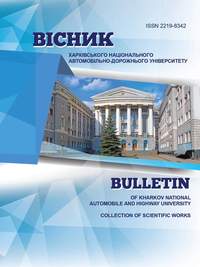NEW APPROACHES IN TEACHING ENGLISH TO STUDENTS OF AUTOMOBILE SPECIALTIES
DOI:
https://doi.org/10.30977/VEIT.2226-9266.2019.16.0.43Abstract
Problem. New approaches in teaching foreign language, especially English as the language of international communication and the most common language in the internet space are the issue of many discussions and researches. Computers and telecommunications that are reshaping higher education, alter the daily operations and expand the missions and opportunities of universities, become the integral part of the teaching process. The students of engineering higher schools, especially future automobile engineers because they are at the cutting edge of modern industry, and, consequently, must be aware of new developments and be able to cooperate with foreign partners, require the combination of traditional and computer-assisted cooperative language learning which provides a space in which the facilitation of learning can take place. However, application of new technologies must be an assisting instrument, but not a self-inclusive tool. The task of a teacher is to be an integral part of the process, not an operator of the computer. Cultivation of students’ capacity of thinking should be the major objective in teaching today. Goal. The goal of the article is proving that the education sector is no exception in our fast developing society. The nature of its target audience – mostly young and highly connected – means that the sector must adapt to the new requirements, which means computer literacy and friendly atmosphere with the main task of facilitating learning. Methodology. Methods of analysis, research and development of new solution were used. Results. In the result of the analysis it was proven that new technologies together with new attitude bring a desired result in teaching foreign language in today’s reality. Originality. Suggestions for using new technologies in the classroom as well as the ways to maintain working atmosphere with friendly communication are made, including the rapport among students themselves. Practical Value. The practical value of the work can be the ideas for improving development of the lesson, using gadgets for combination of individual work and consequent communication, prevention for a teacher from becoming just an assistant of technologies in the process of teaching.
Key words: atmosphere; communication; technology; knowledge; learning; interactive.References
Література
Абдалова О. И. Исакова О. Ю. Использование технологий электронного обучения в учебном процессе. Дистанц. и виртуал. обучение. 2014. № 12. С. 50–55.
Саух П. Ю. та ін. Інновації у вищій освіті: проблеми, досвід, перспективи: монографія. ред. П. Ю. Саух. Житомир: Вид-во ЖДУ ім. І. Франка, 2011. 443 с.
Фатхутдінова О. В. Впровадження нових технологій в процесі підготовки спеціалістів правознавства. Гуманіт. вісн. Запоріз. держ. інж. акад. 2012. Вип. 48. С. 35–39.
Beatty K. Mobile language learning: the world in our hands. Anaheim University, USA. 2015 №17 URL: www.anaheim.edu/schools-and-institutes/ graduate-school-of-education/diplomain-tesol/243-about/faculty-and-staff/tesol-faculty/886-ken-beatty-phd-ken-beatty-phd (дата звернення 10.07.2019)
Brown H. D. Teaching by Principles: An Interactive Approach to Language Pedagogy. New York: Pearson Education. 2007. 3d edition. 569 p.
Dincer A., Goksu A., Takkac A., Yazici M. Common Characteristics of an Effective English. The International Journal of Educational Researchers, 2013. No. 4(3). P. 1–8.
Frank V. M., Freynik S., Richardson D. L. Technologies for foreign language learning: a review of technology types and their effectiveness. Center for Advanced Study of Language, University of Maryland, College Park, MD. 2014. №1. P. 27.
Park G.-P., Lee H.-W. The characteristics of effective English teachers as perceived by high school teachers and students in Korea. Asia Pacific Education Review, 2006. No. 7(2), 236–248 p.
References
Abdalova O. I., Isakova O. Yu. (2014) Ispolzovaniie texnologyy elektronnogo obucheniia v uchebnom processe [Using electronic technologies in teaching process]. Distancz. i virtual. obucheniie. 12. 50–55. [in Russian].
Saukh P. Yu. ta in. (2011) Innovaciyi u vyshhij osviti: problemy, dosvid, perspektyvy [Innovations in higher education: problems, experience, prospects]: monohrafiya. red. P. Yu. Saukh. Zhytomyr: Vyd-vo ZhDU im. I. Franka. [in Ukrainian].
Fathuddinova O. V. (2012) Vprovadzhennia novykh tehnolohii v protsessi pidhotovky spetsialistiv pravoznavstva [Implementation of new technologies in the process of training the law specialists]. Humanit. Visn. Zaporiz. Derzh. Inzh. Akad. 48. 35-39. [in Ukrainian].
Beatty K. (2015) Mobile language learning: the world in our hands. Anaheim University, USA. 17. Retrived from: www.anaheim.edu/schools-and-institutes/graduate-school-of-education/diplomain-tesol/243-about/faculty-and-staff/tesol-faculty/886-ken-beatty-phd-ken-beatty-phd (accessed 10.07.2019)
Brown H. D. (2007) Teaching by Principles: An Interactive Approach to Language Pedagogy. New York: Pearson Education. 3d edition.
Dincer A., Goksu A., Takkac A., Yazici M. (2013) Common Characteristics of an Effective English. The International Journal of Educational Researchers. 4(3). 1–8.
Frank V. M., Freynik S., Richardson D. L. (2014) Technologies for foreign language learning: a review of technology types and their effectiveness. Center for Advanced Study of Language, University of Maryland, College Park, MD. 1.
Park G.-P., Lee H.-W. (2006) The characteristics of effective English teachers as perceived by high school teachers and students in Korea. Asia Pacific Education Review 7(2). 236–248.
Downloads
Published
How to Cite
Issue
Section
License
Copyright (c) 2021 Svitlana Ponikarovska

This work is licensed under a Creative Commons Attribution 4.0 International License.
Автори, які публікуються у цьому журналі, погоджуються з наступними умовами:
1. Автори залишають за собою право на авторство своєї роботи та передають журналу право першої публікації цієї роботи на умовах ліцензії Creative Commons Attribution License, котра дозволяє іншим особам вільно розповсюджувати опубліковану роботу з обов'язковим посиланням на авторів оригінальної роботи та першу публікацію роботи у цьому журналі.
2. Автори мають право укладати самостійні додаткові угоди щодо неексклюзивного розповсюдження роботи у тому вигляді, в якому вона була опублікована цим журналом (наприклад, розміщувати роботу в електронному сховищі установи або публікувати у складі монографії), за умови збереження посилання на першу публікацію роботи у цьому журналі.
3. Політика журналу дозволяє і заохочує розміщення авторами в мережі Інтернет (наприклад, у сховищах установ або на особистих веб-сайтах) рукопису роботи, як до подання цього рукопису до редакції, так і під час його редакційного опрацювання, оскільки це сприяє виникненню продуктивної наукової дискусії та позитивно позначається на оперативності та динаміці цитування опублікованої роботи.








